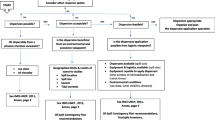Abstract
In recent years, EU countries have recognized national policies to authorize dispersant use to mitigate the petroleum hydrocarbon contamination in case of unintentional oil spills at sea. A harmonization of dispersant approval procedures is needed because the application of different methodologies agrees on dissimilar toxic responses for the same dispersant in different European countries. Actually, different dispersant approval procedures are applied in France and Italy with one French mandatory toxicity test and three Italian bioassays accompanied with different criteria of toxicity classification. In this paper, a harmonized tiered approach is proposed to address the dispersant ecotoxicological assessment in these two nations. Our approach, applicable at the European level, introduces two mandatory tests (algal growth inhibition test and mortality test with crustaceans) and one discretionary test (fish mortality test), by reducing use of vertebrates as much as possible in accordance with humane principles and animal welfare.
Similar content being viewed by others
References
Bejarano AC (2018) Critical review and analysis of aquatic toxicity data on oil spill dispersants. Environ Toxicol Chem 37(12):2989–3001
Bergami E, Pugnalini S, Vannuccini ML, Manfra L, Faleri C, Dawson KA, Corsi I (2017) Long-term toxicity of surface-charged polystyrene nanoplastics to marine planktonic species Dunaliella tertiolecta and Artemia franciscana. Aquat Toxicol 189:159–169. https://doi.org/10.1016/j.aquatox.2017.06.008
EMSA (2016) Overview of national dispersant testing and approval policies in the European Union European Maritime Safety Agency. pp.57
Faraponova O, Lera S, Savorelli F, Palazzi D, Onorati F, Cicero AM, Magaletti E (2007) Valutazione della tossicità acuta di un prodotto disperdente per gli stadi giovanili di quattro specie di crostacei (caso studio). Ricerca, applicazioni e normazione di metodologie ecotossicologiche per la valutazione della qualità degli ambienti marini e salmastri ICRAM, CIBM, Viareggio, Italia. Biol Mar Mediterr 14(1):58–63
GESAMP (2014) (2nd ed.). Revised GESAMP hazard evaluation procedure for chemical substances carried by ships (IMO/FAO/UNESCO-IOC/WMO/ IAEA/UN/UNEP/UNIDO/UNDP) Joint Group of Experts on the Scientific Aspects of Marine Environmental Protection, Rep. Stud. GESAMP No. 64
ICRAM (2005) Programma di Ricerca TAXA - Sperimentazione di test tossicologici su organismi marini, ai fini dell’applicabilità del D.D. 23.12.2002. Relazione finale, pp. 139
IMO/UNEP (2011) Regional information system; Part D – Operational guidelines and technical documents, Section 2, Guidelines for the use of dispersants for combating oil pollution at sea in the Mediterranean region, REMPEC. May edition
ISO 10253 (2016) Water quality - Marine algal growth inhibition test with Skeletonema sp. and Phaeodactylum tricornutum. ISO/TC 147/SC 5, pp. 19
ISO 14669 (1999) Water quality - Determination of acute lethal toxicity to marine copepods (Copepoda, Crustacea). TC/SC: ISO/TC 147/SC 5, pp.16.
Manfra L, Tornambè A, Guyomarch J, Le Guerrogue P, Kerambrun L, Rotini A, Savorelli F, Onorati F, Magaletti E (2017) Dispersant approval procedures in France and Italy: a comparative ecotoxicity study. Ecotoxicol Environ Saf 143:180–185. https://doi.org/10.1016/j.ecoenv.2017.05.044
Mariani L, De Pascale D, Faraponova O, Tornambè A, Sarni A, Giuliani S, Ruggiero G, Onorati F, Magaletti E (2006) The use of a test battery in marine ecotoxicology: the acute toxicity of sodium dodecylsulfate. Environ Toxicol 21(4):373–379. https://doi.org/10.1002/tox.20204
OSPAR Agreement (2015) Guidelines for completing the Harmonised Offshore Chemical Notification Format (HOCNF)
Rotini A, Manfra L, Canepa S, Tornambè A, Migliore L (2015) Can Artemia hatching assay be a (sensitive) alternative tool to acute toxicity test? Bull Environ Contam Toxicol 95(6):745–751. https://doi.org/10.1007/s00128-015-1626-1
UNICHIM MU2396 (2014) Water quality - determination of lethal toxicity at 24 h, 48 h and 96 h exposure for Tigriopus fulvus naupli (Fischer, 1860) (Crustacea: Copepoda)
US EPA (2012) Benchmark dose technical guidance. Risk Assessment Forum, U.S. Environmental Protection Agency, Washington, DC 20460EPA/100/R-12/001 June 2012.
Wise J, Wise JP (2011) A review of the toxicity of chemical dispersants. Rev Environ Health 26(4):281–300
Funding
This work was funded by the RAMOGE Executive Secretariat within the project “Harmonization of protocols and criteria for evaluation and classification of dispersant ecotoxicity” (2018).
Author information
Authors and Affiliations
Corresponding author
Ethics declarations
Conflict of interest
The authors declare that they have no competing interests.
Additional information
Responsible editor: Philippe Garrigues
Publisher’s note
Springer Nature remains neutral with regard to jurisdictional claims in published maps and institutional affiliations.
Rights and permissions
About this article
Cite this article
Manfra, L., Tornambè, A., Guyomarch, J. et al. Could a harmonized tiered approach assess dispersant toxicity in Italy and France?. Environ Sci Pollut Res 27, 30927–30932 (2020). https://doi.org/10.1007/s11356-019-06535-7
Received:
Accepted:
Published:
Issue Date:
DOI: https://doi.org/10.1007/s11356-019-06535-7




